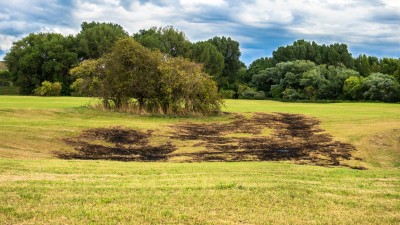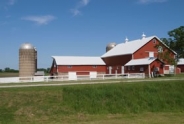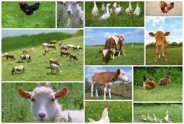Grazing Livestock and Mud Season
Amy Barkley, Team Leader & Livestock Specialist
Southwest New York Dairy, Livestock and Field Crops Program

In many parts of Southwest NY, farmers are in the middle of what is affectionately (or not so affectionately) known as "mud season". In fields with clay-type soil and/or poor drainage, wet ground can stick around until early summer. For graziers, this is unfortunate since the spring flush of cool season grass growth is the largest of the season, and not grazing it can leave money on the table. However, management strategies can play a large role on when you can get out onto a wet pasture and not damaging it when you do.
The greatest damage to a wet pasture is caused by grazing livestock punching up the ground. The relatively small surface area of a hoof compared to the animal's relatively large body weight means that each step that creature takes results in a significant amount of weight in a small area. When that animal steps through the sod, not only does it cause damage to the plants, but it also compacts the soil. Compacted soil loses its porous structure, keeping a wet pasture wetter longer due to exacerbating already poor drainage. It also puts the plants growing in that area at a disadvantage. Plants perform better when a soil's porous structure allows for water and air movement as well as spaces for roots to grow.
While wet pastures are a thorn in the side of some, there are some management strategies to help reduce compaction and plant damage while still taking advantage of early season forage.
1.) Run lighter animal groups
If you have multiple animal groups on the farm, you can choose to run lighter weight ones in wetter pastures. Lighter animal groups may mean a lighter species or something like rotating out feeder calves out instead of brood cows, for instance.
2.) Decrease the stocking density
Drastically decreasing the stocking density can help get some forage from the pasture, but the lower number of animals means less of an impact to the soil. This will not prevent hooves from sinking but will result in fewer repeated punches.
3.) Increase rest periods
Stands that are grazed during wet periods experience damage to both their growing points and root systems. Increasing the rest period (time the animals are off pasture) allows more time for plants to recover.
4.) Don't graze within 3 - 5 days following a rainstorm or poor drying weather
Wet weather results in little drying of the soil, which may make pastures that are otherwise grazable too wet for a few days. Let them dry before turning livestock out.
5.) Choose not to graze until dry conditions persist
The best management strategy for pasture health and longevity is to not graze until it's dry enough to do so.
6.) Take the forage off as hay
There may be an opportunity to take hay off a wet pasture, but careful consideration needs to be made in regard to potential damage the tractor and haying equipment. Lighter equipment with wider tires that can float more easily over the ground surface is recommended here.
While the management strategies above can be successful, they can be further aided by the considerations outlined below:
1.) Soil pH and Fertility
Patchy pastures or pastures with less than optimal forage growth will likely benefit from a soil test, and adjusting the pH and fertility based on the results. Optimized soil nutrition allows for the growth of desired species, filling in patchy or weedy pastures, and increasing the density of the sod.
2.) Species Selection
In wetter pastures, sod-forming species are desirable, since their sod forms a mat which is less easily damaged by grazing livestock. Species such as Kentucky Bluegrass, tall fescue, and bermudagrass are good choices for wet areas. Some seed companies have pasture mixes that are designed to thrive in wet soils and build a dense sod.
3.) Grazing Management
The recommendation when grazing is to take half, leave half. An alternative is grazing plants down to a minimum of 4" before rotating livestock off. Plants like to have a balance of roots and shoots, and grazing too low means that the plant will kill off some of its root system to maintain the balance. To keep the greatest amount of root structure, which stabilizes soil, graze conservatively.
4.) End of Season Management
On pastures that are typically wet at the beginning of the season, leaving 4" - 6" of residual at the end of the season can help give a jump-start to forage growth in the spring, while maintaining a dense root mass.
A special note:
This year, pastures in Southwest NY may dry out faster than in previous years. According to the US Drought Monitor, most of the region is either abnormally dry or in a moderate drought. Even if these normally sodden pastures are drying out nicely now, keep an eye on them. If a normal or heavier rainfall pattern develops, livestock may need to be pulled from the pastures again until the soil dries back out.
Upcoming Events
Boots in the Barn: Cornell Dairy Research Updates
January 13, 2026
January 20, 2026
January 27, 2026
February 3, 2026
February 10, 2026
February 17, 2026
February 24, 2026
Join us for some or all!
Advanced Hoof Health Program
January 15, 2026
Belfast, NY
Who should attend?
- Professional hoof trimmers
- Dairy farm owners or managers in charge of farm foot health
Topics include:
- How to Create a Strategic Trimming Program for your Dairy
- The Latest in Lameness Technology for the Dairy Industry
- Housing and Flooring Design: Its Role in Hoof Care
Webinar: Converting Old Dairy Barns into swine Facilities
January 21, 2026 : Webinar: Converting Old Dairy Barns into swine Facilities
Tim Terry, Farm Strategic Planning Specialist with Cornell's Pro-Dairy program will share information on what it takes to transition an old dairy barn for swine production. We plan to cover flooring, ventilation, and lighting, considerations for system workability, and more! Registration is free.
Announcements
No announcements at this time.





